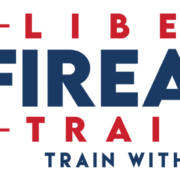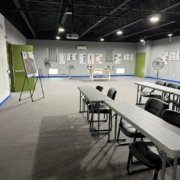It can & does happen everywhere — including here in Baltimore’s Pikesville Jewish community.
If you saw someone walking toward your car in the grocery store parking lot — and you couldn’t see their hands — would you notice in time to act?
If torrential rain started falling during your commute, and flash flood alerts hit your phone, would you know the safest route home — or what roads to avoid?
If someone collapsed in front of you during Shabbos services, does your shul have a medical kit?
Do you know where it is? Do you know the people in shul who are part of Hatzolah? Are you capable of doing CPR or other first-stage emergency medical intervention?
If smoke started filling the hallway during a packed during a wedding event, could you guide your family — and maybe others — to the nearest safe exit without hesitation?
If you heard three sharp pops in the middle of Shabbat services would you recognize the sound, and would you know what to do in the next five seconds to keep yourself and others alive?
If your child finds a firearm, do they know what to do? Do you?
Whether large or small, these situations can be dealt with more efficiently, more securely, and with more confidence through situational awareness.
What Is Situational Awareness?At its core, situational awareness is the ability to recognize what’s happening around you, understand what it means, and respond in a way that keeps you and others safe. It’s not about living in fear — it’s about noticing details that others miss and acting before those details become a threat.
Definition #1 — The OODA Loop (Formal Model)
The OODA Loop — Observe, Orient, Decide, Act — is a proven process used by military, law enforcement, and security professionals.
- Observe – Scan your surroundings with all of your senses — people, vehicles, sounds, smells, movements, environmental changes.
- Orient – Compare what you’re noticing to what’s normal for that environment. Ask yourself: Does anything feel out of place?
- Decide – Choose the safest and most effective response based on what you’ve observed.
- Act – Carry out that decision quickly and decisively
This isn’t a one-time thing — it’s a constant cycle happening in the background of everything you do.
Definition #2 — Everyday, Civilian-Friendly Version
Think of situational awareness as a habit you build into daily life:
- Look Around – Pay attention to what’s happening nearby.
- Understand It – Is it normal or unusual?
- Think Ahead – What will you do if something changes suddenly?
- Do Something – When you need to act, act without hesitation.The same approach works everywhere — from a busy grocery aisle at 7 Mile Market, to a school pickup line with an unfamiliar vehicle, to a minyan where a sound catches your attention or at a gas or charging station for your vehicle.
The Five Categories of Situational Awareness
While the skill is one, the threats and challenges we face are varied. In our Baltimore/Pikesville Jewish community, these fall into five main categories:
1. Crime
We need to break crime into two types:
Opportunity Crimes – These are crimes that happen because a criminal sees an easy target. Recently we’ve seen attempted carjackings by predators who notice you on the phone at a stop light or parked in a lot, not paying attention to your environment, vehicle break-ins because people didn’t lock their doors, and thefts because valuables were left in plain sight. These are preventable by removing the opportunity — locking vehicles, staying alert, putting your phone down, and keeping valuables out of sight.
Hate Crimes – Targeted anti-Semitic attacks, where strangers harass, threaten, or assault people simply because they are visibly Jewish. When walking, look behind you periodically. Walk with at least two people or with a dog. If you’re alone, walk with purpose and maintain a confident posture — it signals you are not an easy target. Do not engage with people yelling hateful things — it serves no benefit. Get to safety and call Shomrim, then the police.
2. Emergencies – Emergencies come in two broad forms — those caused by the weather, and those that are not weather-related. Both require advance thought and the right tools to respond safely.
Weather-Related Emergencies – In Maryland, this often means torrential rains, flash floods, high winds, and storms that knock out electricity. Situational awareness here means checking the forecast before leaving the house, knowing your route, and monitoring conditions. Use tools like Waze for a bird’s-eye view of roads ahead, including closures and hazards. Have an emergency bag in your vehicle with water, tools, extra clothing, snacks, chargers, first aid supplies, and signaling devices. Keep a home kit for power outages and severe storms. Get a generator.
Non-Weather-Related Emergencies – These include vehicle breakdowns, accidents, and other urgent situations that can leave you vulnerable. If your car breaks down, do you have the ability to change a tire? If not, have the number for a tow truck, AAA membership or Chaverim programmed into your phone? Keep safety flares, reflective triangles, or LED beacons in your car to clearly mark your location so you aren’t hit by passing traffic. This is about safety from both accidents and opportunistic crime while stranded.
3. Medical Emergencies
From fainting to cardiac arrest, speed matters. Don’t just call Hatzolah — know where medical kits are in your shul and who has medical training. Take Stop the Bleed, CPR, and basic first aid. If you want to go further, take tactical medicine training. In an emergency, assign roles fast: one calls Hatzolah, one gets the kit, one starts care.
4. Fire
Every building has at least two exits — find them immediately. Don’t assume you’ll leave through the same door you entered. If you live upstairs, have collapsible escape ladders and practice using them with your kids. Fires in our community often start from Shabbos candles, stovetops under a blech, or long-burning appliances. Place candles on sturdy, non-flammable surfaces away from curtains and tablecloths. Monitor stovetops for safety and ventilation. Keep fire extinguishers and first-aid kits in accessible spots. Evacuate first, investigate later.
5. Active Shooter
Pre-Planning – Every shul and school should have an Emergency Operations Plan specific to their environment. Heads of schools, Rabbis and Boards need to consult professionals and community resources to develop it. Evaluate the structures. Are they hard or soft targets? Can a vehicle drive into the building? Do the windows have ballistic film and tinting? Who takes charge? What do people do? Is there a plan for emergency medical care for the victims? What items are cover (objects that stop bullets) and concealment (objects that hide you but don’t stop bullets)? Is there staged furniture if barricading becomes necessary? This is not an extensive list. Failing to plan is a plan for double digit victim counts. Period. There is no excuse in this day and age. If nothing else, the accountability itself should motivate institutions. There are online resources, and there are professionals both within and outside our community who can help write these plans (including us).
In the Moment – If shots are fired, there’s already at least one victim. The first 30 seconds are critical if you want to keep the victim count in the single digits. After that, it goes up fast.
Fight, flee, or hide — in that order. Fight with whatever you have, however you can, with everything you’ve got. It doesn’t matter if you’re untrained, young, old, male, female, adult or child — if you’re able, fight. The data from the last 40 years of active shooters is clear: the sooner the shooter is confronted, the fewer victims there are.
If you can’t fight, flee – create distance. No, you can’t outrun a bullet, but a moving target is harder to hit than someone crouched under a desk. The more distance between you and the shooter the higher your survivability rate is. Run to the closest cover you can find. If the shooter is in a building, get out. If the shooter is outside, get in.
If you can’t fight or flee, hide behind cover if you can, concealment if you can’t — but know that walls, doors, and windows do not stop bullets. Active Shooters have fired through all of them to hit their targets.
Teaching Your Children Situational Awareness
Start as young as you can and be consistent. Make it fun and normal, not scary.
Turn it into a game:
- In the car: “Without looking, what color is the car next to us?”
- Walking: “Can you describe what that person is wearing?”
- In a building: “Find me two ways out of here.”
- On the street: “What’s different about this block today?”
Teach them to recognize safe adults they can approach if they’re lost — police officers, security guards, store clerks, trusted community members. Teach them to identify sounds — sirens, barking dogs, approaching vehicles. Practice keeping personal space in public.
With older kids, practice memorizing parts of license plates or noticing routes and spotting changes.
Firearm Safety for All Children
Even if you don’t own a gun, your child may encounter one elsewhere. Kids get into everything.
They visit friends’ homes. And yes, many homes in this community have firearms — some stored responsibly, some not.
The NRA’s Eddie Eagle GunSafe® Program teaches four steps every child should know:
- Stop
- Don’t Touch
- Run Away
- Tell a Grown-Up
Practice these often so the reaction is automatic. This isn’t about fear — it’s about safety. If you practice these skills — and teach them to your children — situational awareness becomes more than an idea. It becomes a habit. And habits save lives.
About the Author & Liberty Firearms Training
Yacov Margolese is the Founder and Lead Instructor of Liberty Firearms Training (LFT), a veteran-owned training organization serving the Baltimore/Pikesville Jewish community and surrounding areas. A decorated U.S. Army combat veteran, retired Federal law enforcement officer, and former Federal security contractor, Margolese is also a current Maryland State Police Certified Firearms Instructor, credentialed through both the NRA Law Enforcement Division and the NRA Civilian Division. With more than two decades of operational and training experience, Margolese specializes in situational awareness, threat recognition, emergency response, and defensive firearms training— bringing practical, real-world application to every course. This foundation is reflected in LFT’s guiding principle: Train with Purpose!
Liberty Firearms Training offers a full range of safety and defensive programs, including:
- Situational Awareness seminars tailored to your shul, school, or business needs.
- Emergency Operations Plan (EOP) development for shuls, schools, and community institutions.
- Fundamentals of emergency medicine and tactical medical training.
- Defensive firearms training at all levels, including Maryland Handgun Qualification
- License (HQL) and Wear & Carry (concealed carry) permit courses.
- Concierge-style firearms instruction, available one-on-one or in small private groups for maximum personal attention.
- Firearm safety education for all ages.
For more information or to schedule training:
443-929-0028
Contact@LibertyFirearmsTraining.org
www.LibertyFirearmsTraining.org
P.S. Since Oct. 7th Liberty Firearms Training has offered the Situational Awareness Seminar for FREE to all shuls in Baltimore. The Seminar is 90 minutes consisting of a 60 minute presentation and 30 minutes of Q&A. We have already been presented at multiple shuls and more are in the works. This is an OPEN offer.







